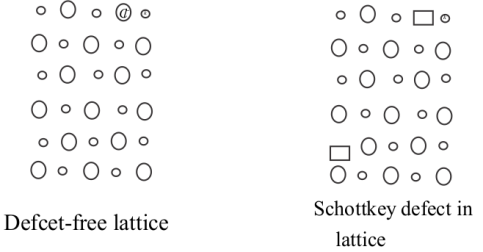
Which kind of point defect is found in \[KCl\] crystal ?
A. Frenkel
B. Schottky
C. Linear
D. Impurity
Answer
570.6k+ views
Hint: There are three types of point defects ie stoichiometric defect, Frenkle defect and schottky defect. These are the imperfections in crystal lattice due to missing atoms or ions, it creates a vacancy for extra atoms or ions.
Complete step by step answer: $KCl$ is an ionic compound, having small difference in size of cations and anions present in the crystal lattice.
In such compounds, more examples :
$NaCl,KBr,CsCl\;and\;AgBr,$the point defect seen is schottky defect. Schottky defects consist of cations and anions in stoichiometric ratio that are unoccupied.
Simple structure of ionic crystal is ${A^ - }{B^ + }.$
This defect was named after walter H schottky, who demonstrated that in crystal lattice, oppositely charged ions ie. Cation and anion leave their sites and get incorporated at surface for instance and create oppositely charged vacancies in stoichiometric units and maintain overall neutral charge on ionic solid .
Two dimensional diagram of this defeat for $KCl$ is :-

Due to schottky defect, the density of the solid crystal lattice becomes lower than actual theoretical density.
So, the correct answer is “Option B”.
Note: Both anion and cation leave the solid crystal and permanently move out of it. Generally , the number of Vacancies formed is two.
The number of schottky defects can be calculated by using the formula
$ns = Next\left( {\frac{{ - \Delta Hs}}{{2RT}}} \right)$
Where, $ns = $ number of Schottky defects per unit volume.
$R = $gas constant
$\Delta H = $enthalpy of defect formation
$T = $ Temperature in kelvin.
Complete step by step answer: $KCl$ is an ionic compound, having small difference in size of cations and anions present in the crystal lattice.
In such compounds, more examples :
$NaCl,KBr,CsCl\;and\;AgBr,$the point defect seen is schottky defect. Schottky defects consist of cations and anions in stoichiometric ratio that are unoccupied.
Simple structure of ionic crystal is ${A^ - }{B^ + }.$
This defect was named after walter H schottky, who demonstrated that in crystal lattice, oppositely charged ions ie. Cation and anion leave their sites and get incorporated at surface for instance and create oppositely charged vacancies in stoichiometric units and maintain overall neutral charge on ionic solid .
Two dimensional diagram of this defeat for $KCl$ is :-

Due to schottky defect, the density of the solid crystal lattice becomes lower than actual theoretical density.
So, the correct answer is “Option B”.
Note: Both anion and cation leave the solid crystal and permanently move out of it. Generally , the number of Vacancies formed is two.
The number of schottky defects can be calculated by using the formula
$ns = Next\left( {\frac{{ - \Delta Hs}}{{2RT}}} \right)$
Where, $ns = $ number of Schottky defects per unit volume.
$R = $gas constant
$\Delta H = $enthalpy of defect formation
$T = $ Temperature in kelvin.
Recently Updated Pages
Why are manures considered better than fertilizers class 11 biology CBSE

Find the coordinates of the midpoint of the line segment class 11 maths CBSE

Distinguish between static friction limiting friction class 11 physics CBSE

The Chairman of the constituent Assembly was A Jawaharlal class 11 social science CBSE

The first National Commission on Labour NCL submitted class 11 social science CBSE

Number of all subshell of n + l 7 is A 4 B 5 C 6 D class 11 chemistry CBSE

Trending doubts
What is meant by exothermic and endothermic reactions class 11 chemistry CBSE

10 examples of friction in our daily life

One Metric ton is equal to kg A 10000 B 1000 C 100 class 11 physics CBSE

1 Quintal is equal to a 110 kg b 10 kg c 100kg d 1000 class 11 physics CBSE

Difference Between Prokaryotic Cells and Eukaryotic Cells

What are Quantum numbers Explain the quantum number class 11 chemistry CBSE




